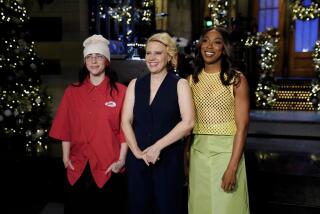The Christmas variety TV special is out of season
Roll over Bing Crosby, and tell Perry Como the news: Christmas variety specials on TV are getting a lump of coal from viewers.
Once a holiday staple â the same week in 1973, easy-listening stars Como and Andy Williams each drew more than 40% of the TV audience with their respective Christmas shows â the format has lately proved about as popular as sour eggnog. Thatâs true even when a huge star is on the marquee. ABCâs âA Very Gaga Thanksgiving,â a vehicle for pop diva Lady Gaga, last month produced very un-Gaga-like ratings. NBCâs âMichael BublĂŠ Christmas,â starring the popular retro crooner, spread cheer to just 7.1 million viewers â and was beaten by a repeat of âNCIS.â
But lackluster ratings arenât the only factor â celebrities and networks alike seem to be taking a holiday from the genre, although one TV executive says that may soon change. The seasonâs schedules nowadays are more likely to be filled with old animated fare like âRudolph the Red-Nosed Reindeer,â the 1964 stop-motion classic from Rankin/Bass that last month delivered 12.6 million viewers for CBS â making it this yearâs No. 1 Christmas special.
So whatâs the problem with variety shows? Todayâs would-be Bob Hopes have a lot of competition, experts say.
âThere was no MTV or Nickelodeon to run to,â television historian Tim Brooks said of the Christmas variety specialsâ golden era during the 1960s and 1970s.
The growth of cable television, coupled with the emergence of new musical forms that appeal to ever-narrower niches, has made it nearly impossible to create a one-size-fits-all special.
âBecause of this fragmentation we havenât been able to develop stars with extremely broad appeal who could carry a Christmas special,â Brooks said.
Itâs all a long way from 40 years ago, when cozy specials featuring cardigan-wearing hosts sipping hot chocolate and fondling yuletide props became as ubiquitous as âSilent Night.â
An early leader in the category was Crosby, the smooth pop crooner who became synonymous with the holidays due to his recording of âWhite Christmas,â often cited as the bestselling record of all-time.
Reviewing Crosbyâs TV special in 1963, Cecil Smith of the Los Angeles Times wrote: âAs Bingâs voice was the voice of America to many of us during the war (Tokyo Rose graciously played Crosby records by the stack) his voice is now the voice of Christmas to me.â
Hope, Crosbyâs sometime movie partner who began doing Christmas shows for the U.S. military in 1942, turned them into a perennial event (although because they were taped overseas, NBC would air them in January, well after the holidays were over). In 1980, NBCâs âBob Hope Christmas Specialâ drew more than 27 million viewers, according to Nielsen.
The holly-and-ivy market grew so crowded that song-and-dance woman Mitzi Gaynor had to reassure The Times in 1967 that âour show is different â really.â By the late 1970s, even entertainers such as singer John Davidson and magician Doug Henning had Christmas specials. Most were forgotten as quickly as last yearâs stocking stuffers, although some bits have survived: An unlikely mash-up with David Bowie from 1977âs âBing Crosbyâs Merrie Olde Christmasâ has remained popular, with more than 1 million YouTube hits.
Such holiday fare conformed to the notion of âleast objectionable programmingâ that then held sway at ABC, CBS and NBC, according to Robert J. Thompson, founding director of the Bleier Center for Television and Popular Culture at Syracuse University. The performers tended to be white, middle-of-the-road entertainers, often out of step with the rock and soul revolutions then seizing the music industry. But in a three-channel universe, TV programmers felt constrained to aim as broadly as possible.
âIt was during the network era, when you didnât expect any demographic to really love it,â Thompson said of the Christmas shows. âBut every demographic could tolerate it.â
As the old generation faded away, younger pop performers have tried to pick up the garland. In 2003, VH1 aired âA Kid Rock Christmasâ â whose host is not typically associated with the holidays. That same year, MTV trotted out a special starring Ozzy Osbourne and his brood at the height of their reality showâs popularity. But lately the specials have slowed to a trickle, with Gaga and BublĂŠ virtually alone among stars trying to make a go of it.
BublĂŠâs special had fewer viewers this year than old animated hits such as âHow the Grinch Stole Christmasâ and âA Charlie Brown Christmas.â Yet NBC nevertheless saw it as a path back to the holiday specials business.
âWe saw that as sort of a dipping our toe back in the water, and one that weâre extremely pleased with the result from a ratings point of view and just general critical reception,â said Paul Telegdy, president of alternative and late-night programming for NBC. âMichael is an artist that actually has a surprisingly broad and deep reach.â
That means that even if Christmas specials have waved goodbye for now, a la Frosty the Snowman, theyâll be back someday.
âI think we have the talent contacts and the talent on our own air to pull something like this together,â Telegdy said. âThereâs something about the nostalgia.â
More to Read
The complete guide to home viewing
Get Screen Gab for everything about the TV shows and streaming movies everyoneâs talking about.
You may occasionally receive promotional content from the Los Angeles Times.








